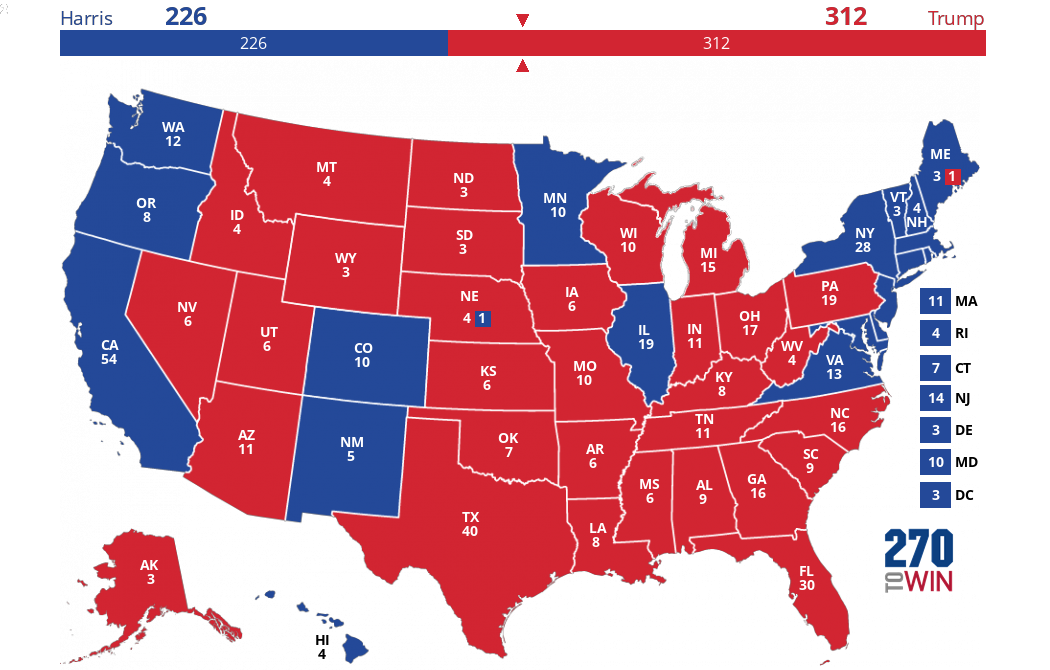Maryland
Maryland, one of the original 13 colonies, entered the Union in April 1788 and has participated in all 59 presidential elections. Maryland has been primarily a “blue” state since the founding of the modern political parties (around the time of the Civil War). Since 1960, Maryland has voted Republican only in the landslide wins of Richard Nixon in 1972, Ronald Reagan in 1984 and George H. W. Bush in 1988. In 2024, Kamala Harris won by 63% to 34% over Donald Trump.
ELECTORAL VOTES
10Recent Presidential Elections
| 2024 |
|
|||
| 2020 |
|
|||
| 2016 |
|
|||
| 2012 |
|
|||
| 2008 |
|
|||
| 2004 |
|
|||
| 2000 |
|
Presidential Voting History
State voted with the overall winning candidate
Electoral College Votes
Colored bars represent electoral votes by party. Tap or hover to see names.
Gray indicates available electoral votes that were either not cast or cast for a candidate not on the ballot.
U.S. Senate Voting History
| Class† | 1988 | 1990 | 1992 | 1994 | 1996 | 1998 | 2000 | 2002 | 2004 | 2006 | 2008 | 2010 | 2012 | 2014 | 2016 | 2018 | 2020 | 2022 | 2024 |
|---|---|---|---|---|---|---|---|---|---|---|---|---|---|---|---|---|---|---|---|
| 1 |
D
|
D
|
D
|
D
|
D
|
D
|
D
|
||||||||||||
| 2 | |||||||||||||||||||
| 3 |
D
|
D
|
D
|
D
|
D
|
D
|
Data: MIT Election Data and Science Lab / Harvard Dataverse through 2018; 270toWin research. These are general election results for the years listed. Special elections, if any, are excluded.
† There are three classes of Senators; one is up for election every second year. Each state has one Senator in two of the three classes.
U.S. House Voting History
| District | 1988 | 1990 | 1992 | 1994 | 1996 | 1998 | 2000 | 2002 | 2004 | 2006 | 2008 | 2010 | 2012 | 2014 | 2016 | 2018 | 2020 | 2022 | 2024 |
|---|---|---|---|---|---|---|---|---|---|---|---|---|---|---|---|---|---|---|---|
| 1 |
D
|
R
|
R
|
R
|
R
|
R
|
R
|
R
|
R
|
R
|
D
|
R
|
R
|
R
|
R
|
R
|
R
|
R
|
R
|
| 2 |
R
|
R
|
R
|
R
|
R
|
R
|
R
|
D
|
D
|
D
|
D
|
D
|
D
|
D
|
D
|
D
|
D
|
D
|
D
|
| 3 |
D
|
D
|
D
|
D
|
D
|
D
|
D
|
D
|
D
|
D
|
D
|
D
|
D
|
D
|
D
|
D
|
D
|
D
|
D
|
| 4 |
D
|
D
|
D
|
D
|
D
|
D
|
D
|
D
|
D
|
D
|
D
|
D
|
D
|
D
|
D
|
D
|
D
|
D
|
D
|
| 5 |
D
|
D
|
D
|
D
|
D
|
D
|
D
|
D
|
D
|
D
|
D
|
D
|
D
|
D
|
D
|
D
|
D
|
D
|
D
|
| 6 |
D
|
D
|
R
|
R
|
R
|
R
|
R
|
R
|
R
|
R
|
R
|
R
|
D
|
D
|
D
|
D
|
D
|
D
|
D
|
| 7 |
D
|
D
|
D
|
D
|
D
|
D
|
D
|
D
|
D
|
D
|
D
|
D
|
D
|
D
|
D
|
D
|
D
|
D
|
D
|
| 8 |
R
|
R
|
R
|
R
|
R
|
R
|
R
|
D
|
D
|
D
|
D
|
D
|
D
|
D
|
D
|
D
|
D
|
D
|
D
|
Data: The Princeton Gerrymandering Project through 2018; 270toWin research. These are general election results for the years listed. Special elections, if any, are excluded.
Vertical lines before 1992, 2002, 2012, and 2022 show Census-related redistricting breakpoints. Geographic borders associated with each district number are likely to have changed.
Governor Voting History
Data: Wikipedia through 2018; 270toWin research. These are general election results for the years listed. Special elections, if any, are excluded.

